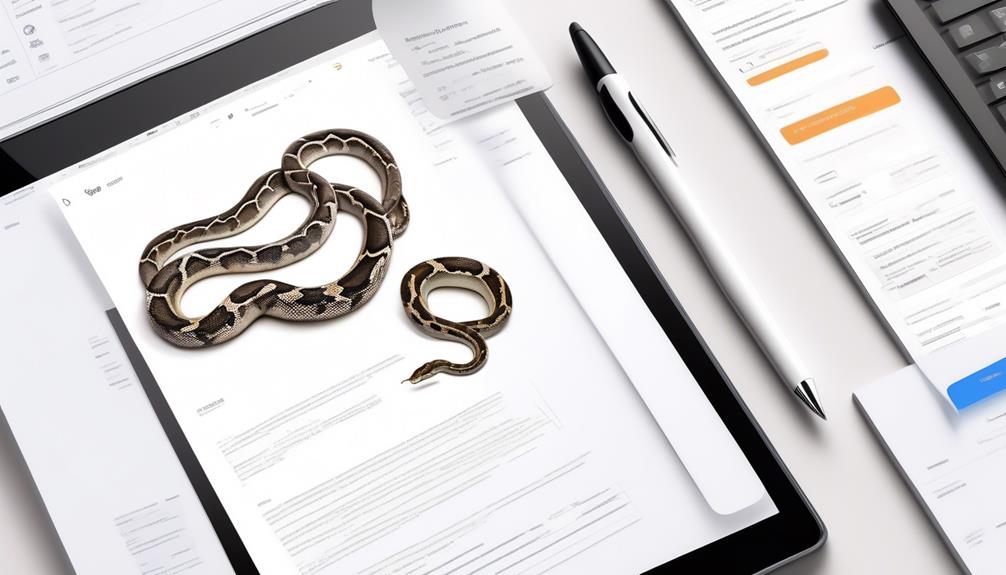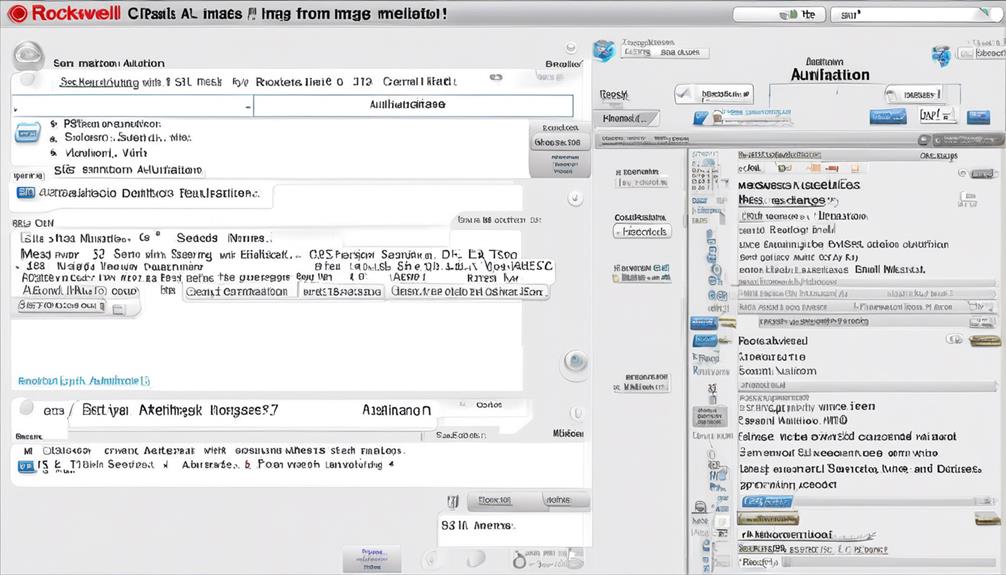Regarding optimizing email tasks, there exists a formidable solution that might be unknown to some: Python Email Automation.
With Python, we can automate various email tasks, from sending customized messages to scheduling emails for optimal delivery times. The efficiency and simplicity of Python make it an ideal choice for individuals and businesses seeking to enhance their email marketing efforts or handle repetitive email-related tasks with ease.
But how exactly does Python enable this automation, and what are the potential benefits for your workflow?
Let's explore how Python Email Automation can revolutionize the way we handle our email communications.
Key Takeaways
- Understanding the prerequisites for Python Email Automation, including Python concepts and familiarity with the smtplib package.
- Setting up the email server connection by gathering server configuration details, authenticating the email account, and configuring SSL for secure transmission.
- Proper email account authentication and enabling TLS encryption for secure and reliable communication.
- Establishing a secure connection using the smtplib.SMTP class, enabling encryption with starttls(), identifying the client to the server with ehlo(), and authenticating the connection with email and password.
Prerequisites
Before diving into Python email automation, it's essential to have a basic understanding of Python concepts.
Familiarizing with the smtplib package is crucial for automating email sending using Python. This package allows us to send emails using the Simple Mail Transfer Protocol (SMTP).
Understanding the port number for the email server based on the chosen service is also essential. Different email services use different port numbers for communication, and knowing this information is crucial for successful email automation.
Additionally, learning to use the MIME modules for adding different types of content to emails is recommended. This allows for the inclusion of attachments, HTML content, and more, making the emails more versatile and effective.
Lastly, customizing and sending personalized emails by looping through a CSV file with personalized information is an important prerequisite for Python email automation. This allows for the efficient sending of personalized emails to a large number of recipients, a key feature in many email automation scenarios.
Set Up Email Server Connection

First, we'll need to gather the specific server configuration details, including the server address and port number, to establish the connection.
Next, we'll authenticate our email account by providing our credentials using the login() method, ensuring a secure connection to prevent unauthorized access.
Server Configuration Details
How can we ensure a secure connection with the email server while setting up the email server connection in Python?
To establish a secure connection, we utilize the smtplib.SMTP class to initiate the connection and specify the port.
We then employ the ehlo() method to identify the client to the server and enable encryption using the starttls() method.
Subsequently, we authenticate the connection with the server, ensuring confidentiality by using the login() method with our email and password.
It's imperative to configure SSL for email transmission to prevent unauthorized access.
Prior to initiating the connection, we must verify that our Python installation supports SSL for secure email transmission.
Email Account Authentication
When setting up the email server connection in Python, we ensure a secure connection by utilizing the smtplib.SMTP class to initiate the connection, specifying the port, and enabling encryption using the starttls() method.
After the connection is established, it's crucial to authenticate with the email server using the login() method to prevent unauthorized access and ensure secure communication. This authentication process is essential for automating sending emails securely.
By employing the starttls() method, we enable TLS encryption for the communication, adding an extra layer of security.
Ensuring proper email account authentication is fundamental in the process of Python email automation, as it helps prevent unauthorized access and protects sensitive information from potential threats. This authentication step forms a critical part of the overall email automation process, guaranteeing secure and reliable communication.
Establishing Secure Connection
To establish a secure connection with the email server, we utilize the smtplib.SMTP class to initiate the connection and specify the port for encryption using TLS.
After identifying the client to the server with the ehlo() method, we enable encryption using the starttls() method. This ensures that the communication is protected by Transport Layer Security (TLS).
Authentication is essential for establishing a secure connection, and we achieve this by using the login() method with our email and password.
It's crucial to select the appropriate port number for the email server, as it varies depending on the chosen service.
Add Content Using MIME

Using the MIMEMultipart module in Python allows for creating MIME documents for a multipart message, supporting plain text and HTML languages.
When adding content to emails using MIME, the following methods can be employed:
- Utilize MIMEText module to include plain text content in the email, ensuring compatibility with a wide range of email clients and providing a fallback option for users with email clients that don't support HTML.
- Incorporate images into the email by using the MIMEImage module, enabling the seamless display of visuals within the email body to enhance the overall messaging and user experience.
- Attach files to the email using the MIMEApplication module, allowing for the inclusion of various file types as attachments by specifying the file path and reading its binary data.
Send Customized Emails

After adding content to emails using MIME, we can now proceed to discuss how to send customized emails, a crucial aspect of Python email automation. Sending customized emails involves utilizing the smtplib Python package to establish a connection with the email server and authenticate using the login() method. By employing MIME modules like MIMEMultipart, MIMEText, and MIMEImage, various types of content such as plain text, HTML, and images can be added to the email.
To customize email content, one can create a CSV file with personalized information, replace placeholders with actual values, and then send personalized emails to recipients using the sendmail() function. This process allows for the efficient and personalized distribution of emails with Python.
Additionally, Python email automation involves libraries like smtplib and imaplib for interacting with email servers, enabling tasks such as scheduling emails and setting up automated responses. It's also worth considering alternative email service providers like Mailmodo for easier setup and access to pre-designed templates, visual journey builders, and built-in analytics, enhancing the automated email process.
Tips & Best Practices

As we consider best practices for Python email automation, it's crucial to focus on email content tips and the utilization of automation tools.
By ensuring that the content of our emails is well-crafted and personalized, we can enhance the effectiveness of our automated communication.
Additionally, leveraging automation tools can streamline the process and improve the overall efficiency of our email automation endeavors.
Email Content Tips
Consider incorporating personalized information into email content using a CSV file and the str.format() function for enhanced customization. This allows for dynamic content generation, making each email recipient feel valued and engaged.
When implementing email content tips in Python email automation, it's essential to:
- Use the MIMEMultipart module to create MIME documents representing a multipart message, supporting plain text and HTML languages.
- Ensure proper permissions, legal rights, and secure connections (SSL/TLS) when sending automated email messages, and thoroughly test the functionality before deploying it in a production environment.
- Implement interactive elements like forms, carts, calendars, and games to increase email engagement and conversions, utilizing app-like features to provide a seamless user experience.
These practices enhance the effectiveness of email campaigns and contribute to a more personalized and engaging user experience.
Automation Tools
To seamlessly integrate the practices of email content customization discussed in the previous subtopic, we will now explore essential tips and best practices for utilizing automation tools in Python. When working with Python email automation, it's crucial to understand the capabilities of automation tools such as smtplib and MIME modules. These tools enable efficient handling of email sending and receiving processes programmatically. Below, we present a table summarizing some key automation tools and their functions.
| Automation Tool | Function |
|---|---|
| smtplib | Establish secure connections with email servers |
| MIME modules | Include attachments, HTML content, and personalized text in emails |
System Requirements

Ensuring seamless integration with Python and the necessary libraries is essential for meeting the system requirements of Python email automation. To achieve this, it's imperative to adhere to the following system requirements:
- Python Installation: Ensure that Python is installed on the system. Python 3.x is recommended for its improved features and support.
- Import Using Python: Import the required libraries using Python's package manager, pip. Use the command `pip install secure-smtplib` to install the smtplib library for secure email transmission.
- SSL Support: Enable SSL support for secure email transmission. This can be achieved by ensuring that the SSL module is installed and properly configured within the Python environment.
Setup Python Email Automation

After meeting the system requirements for Python email automation, the next step is to set up the automation process by configuring the necessary email parameters and authentication. To automate sending emails using Python, it is essential to establish a connection with the email server and authenticate the sender's credentials. Below is a table outlining the key parameters and authentication details required for setting up Python email automation:
| Parameter | Description |
|---|---|
| Email Server Address | Address of the SMTP server for outgoing emails |
| Port Number | Port used for communication with the SMTP server |
| Sender's Email | Email address of the sender |
| Sender's Password | Password for the sender's email account |
Configuring these parameters and ensuring proper authentication is crucial for the successful automation of sending emails using Python. Once these details are set up, the Python script can be written to utilize the smtplib library and the MIMEMultipart module for creating and sending personalized emails efficiently. This approach to automate sending emails using Python simplifies the process and enhances productivity in various email communication tasks.
Steps to Setup Automation

As we delve into setting up the automation process, understanding the key parameters and authentication details becomes essential for seamless Python email automation. Here are three crucial steps to successfully set up automation and send out emails:
- Familiarize with Python and smtplib Package:
Begin by gaining a solid understanding of Python and the smtplib package, which is essential for sending emails using Python. It's important to learn how to establish a secure connection with the email server using the smtplib.SMTP class.
- Utilize MIME Modules for Content:
Explore the usage of MIME modules to add various types of content, such as plain text, HTML, images, and attachments to the emails. Understanding how to manipulate these modules will allow for the creation of diverse and engaging email content.
- Personalize Email Content:
Discover methods to customize email content according to specific needs. This involves learning how to incorporate personalized elements into the email body, subject, and attachments, enabling the creation of tailored and effective email communications.
Alternative to Python Automation

An effective alternative to Python email automation is the user-friendly, no-code email service provider, Mailmodo, which offers intuitive features and a wide range of pre-designed email templates. Mailmodo provides a seamless solution for email automation without the need for writing code. Here's a comparison between using Python for email automation and using Mailmodo:
| Features | Mailmodo | Python email automation |
|---|---|---|
| Ease of Use | User-friendly interface | Requires coding proficiency |
| Email Templates | 300+ pre-designed templates | Templates need to be created |
| Analytics | Built-in analytics for campaign insights | Manual setup for analytics |
| Automated Workflows | Visual journey builder for automated emails based on customer actions | Custom scripting for workflows |
Email Automation Campaign

When setting up an email automation campaign, it's crucial to consider the target audience selection and email content personalization.
By using Python, we can efficiently customize emails to cater to the specific needs and preferences of different recipients.
This approach enhances engagement and improves the overall effectiveness of the email automation campaign.
Target Audience Selection
Selecting the target audience for an email automation campaign involves identifying specific demographics or characteristics tailored to the campaign's objectives. To effectively target the audience, we utilize data-driven approaches and segmentation techniques such as:
- Understanding Preferences: We analyze the preferences, interests, and behaviors of the target audience to tailor the content and timing of the emails accordingly.
- Data-Driven Segmentation: Segmentation based on factors like age, location, or previous interactions ensures personalized and targeted communication.
- A/B Testing: Testing different audience segments allows us to determine which groups are most responsive, providing valuable insights for optimizing the email content and offers.
Utilizing a Python script for email automation enables us to efficiently manage and customize communication with the selected target audience, leading to improved engagement and conversions.
Email Content Personalization
Utilizing the insights gained from targeted audience segmentation, we now turn our focus to the implementation of personalized email content in our email automation campaign.
Email content personalization involves tailoring the email's subject, body, and attachments to the specific needs and preferences of the recipients. This customization can be achieved by utilizing recipient-specific data such as their name, past interactions, purchase history, or demographic information.
By incorporating personalized content, we can significantly improve engagement, response rates, and the overall effectiveness of our email marketing campaigns.
To implement email content personalization, we can utilize libraries or modules in email automation tools like Python's smtplib and MIME, which enable the creation and sending of customized emails.
Incorporating personalization in our email automation strategy can greatly enhance the impact of our email campaigns.
Takeaway

Takeaway provides a simple and efficient solution for automating email sending and receiving tasks using Python. This powerful tool streamlines the process of sending personalized emails to recipients by replacing placeholders with actual values from a CSV file. With Takeaway, users can easily handle various types of content in emails, including plain text, HTML, images, and attachments using MIME modules. This ensures that the emails aren't only personalized but also visually appealing and informative.
Using Takeaway to automate sending and receiving emails can significantly enhance an individual's problem-solving skills, job opportunities, creativity, and logical thinking. It provides a competitive advantage in the professional world by enabling timely submission of applications and streamlining the job application process.
The ability to automate email tasks with Takeaway saves time and effort, allowing users to focus on other critical aspects of their work. This proficiency in automating email tasks using Python can set individuals apart in today's competitive job market and contribute to their overall productivity and efficiency.
Schedule Email Messages

Scheduling Email Messages allows for precise timing and organization of email campaigns, minimizing manual effort and ensuring timely delivery. With Python email automation, you can easily schedule emails to be sent at specific dates and times, optimizing the impact of your communication. This feature is particularly useful for planning and coordinating email campaigns in advance, reducing the need for constant manual intervention. By leveraging a Python script for email automation, you can streamline the process of scheduling emails and ensure that they reach recipients at the most suitable times.
To illustrate the potential of scheduling email messages, consider the following table:
| Use Case | Benefits | Example |
|---|---|---|
| Marketing Campaigns | Reach global audience at optimal times | Schedule promotional emails for peak engagement hours |
| Event Reminders | Ensure timely delivery of important information | Schedule event reminders for specific date and time |
| Newsletters | Organize and plan email content in advance | Schedule monthly newsletters for consistent delivery |
What are the differences between Python Email Automation and Pardot Email Automation?
Python Email Automation offers a more flexible and customizable approach to handling emails, while Pardot Email Automation solution provides a comprehensive and integrated platform for marketing automation. Python Email Automation allows for more personalized communication, but Pardot Email Automation solution offers more robust analytics and lead management features.
Implementation

Transitioning from the concept of scheduling email messages, we'll now focus on the practical implementation of Python email automation.
This implementation involves setting up and using the `smtplib` package to send emails. When implementing Python email automation, it's essential to consider the following:
- Utilizing the `smtplib` and `imaplib` libraries: Python email automation implementation involves interacting with email servers and automating tasks like scheduling and automated responses. The `smtplib` library is crucial for sending emails, while the `imaplib` library can be used for accessing and retrieving emails from an inbox.
- Creating MIME documents for different content types: Implementing email automation includes creating MIME documents for various content types such as text, HTML, images, and attachments. This ensures that the email can support different types of content and is displayed correctly across different email clients.
- Personalizing emails using recipient-specific data: When implementing personalized emails, a CSV file with recipient-specific data can be utilized to customize the email content. This allows for the automation of personalized email communication, enhancing engagement and relevance.
Frequently Asked Questions
Can Python Automate Emails?
Yes, we can automate emails using Python.
We achieve this by leveraging Python's smtplib library for sending emails through various email services.
Additionally, the MIME modules in Python enable us to include various content types like plain text, HTML, images, and attachments to emails.
This automation process allows us to save time and effort, especially in tasks such as scheduling emails and setting up automated responses.
Can You Send Email Using Python?
Yes, we can send emails using Python. We utilize libraries like smtplib and MIMEMultipart to connect to email servers and create and send emails. This process allows for customization of content, including plain text, HTML, and attachments.
Additionally, we can personalize emails by integrating data from CSV files. Automating email tasks with Python enables efficient scheduling and automated responses, benefiting both individuals and businesses.
How Do I Create an Email in Python?
We create emails in Python using the MIMEMultipart module to generate various content types, such as plain text, HTML, images, and attachments.
We then use the built-in smtplib package to send the emails to desired recipients.
This approach allows for customization and personalization of emails, making it an efficient method for managing email communication.
How Do I Schedule an Email in Python?
We schedule emails in Python by using the `schedule` library to set up a recurring job for sending emails at specific times.
We create a function to handle the email sending process and then schedule it to run at the desired time using the library's syntax.
This allows us to automate the process of sending scheduled emails, making it efficient and time-saving.
Conclusion
In conclusion, Python email automation allows for efficient and effective email management.
By streamlining tasks such as sending customized emails, scheduling messages, and implementing email campaigns, Python provides a powerful platform for email automation.
With the ability to save time and effort, Python email automation is a fantastic tool for businesses and individuals alike, offering a seamless and sophisticated solution for all their email needs. In addition to Python email automation, businesses can also benefit from using salesforce email automation to streamline their communication and marketing efforts. By integrating these tools into their operations, companies can effectively reach out to their customers, manage their email marketing campaigns, and track their engagement and conversion rates. This combination of technologies can greatly improve productivity and efficiency, ultimately leading to better outcomes for businesses and their clients.










